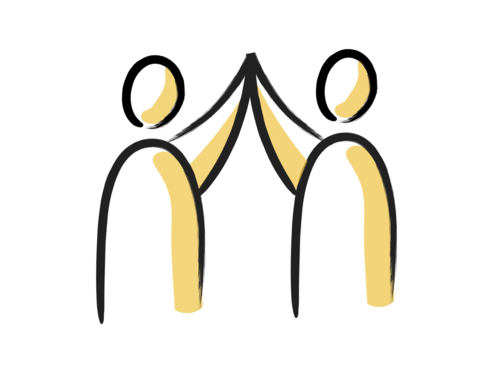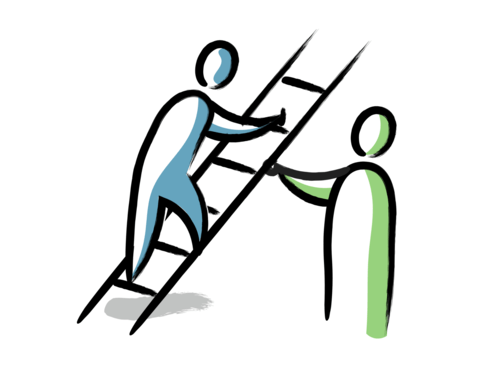5 Habits of Great Leaders
While every great leader is unique in his or her own way, there are habits common to many effective leaders, which you can glean and apply to your own practice.
At ALJ, we emphasize the importance of recognizing our default behaviors—those automatic reactions that we have when leading. Some of these default behaviors may serve you well, but they could be hindering your ability to elevate to a catalyst leader if you are not deliberate in your approach. Incorporating the habits identified below may help you boost your leadership agility.
Habit 1: Make Time to Reflect
Great leaders are not born.
They develop through deliberate reflective practice.
Time is hard to come by. But there is probably little better use for time than reflection. Reflecting on your day, the actions taken, the interactions had or avoided, the incremental progress made, the highs and lows, and everything in between is immeasurably helpful for improving your leadership and life. When we take a second to reflect, we can learn from our own experiences and feel more accurately about how it is unfolding. You can see where you made intentional action, where you fell into a default behavior, and assess how either of those resulted in the product of your day.
How to start: Create a calendar reminder or block time off near the end of the day and/or week for deliberate reflection. Use this time, to look at the back and see where it was successful, what shortcomings can be corrected, and what defaults you might have fallen back on.
Look ahead and purposefully plan for upcoming priorities, focus and engagement. Hold yourself accountable, but don’t be harsh on yourself. Everyone makes mistakes. What’s important is developing awareness about your leadership, learning from your experiences (especially your mistakes and failures), and putting into practice different approaches to enhance your leadership. Journaling is one way to capture such reflections, providing the opportunity to put thoughts into words, images or recordings and to also have the ability to later look back on past reflections for patterns and progress.
Habit 2: Pursue New Ways of Thinking
Great leaders are not done.
They continue to strive for excellence.
This habit is closely tied to the previous one. Often, reflection inspires us to seek out new ways of thinking. But sometimes an external source can spark your interest or shed light on a different approach . Be it reading, as Warren Buffet does, or engaging in conversation with other leaders, or practicing a skill you have no familiarity with. The only way to a possible better future self is to deliberately seek new doors, open them, and step through to explore.
How to start: Make learning a part of your focus. Just like fitness and health, learning is a habit of practice Whether you pick up a book, take an online class, listen to a podcast, meet up with other leaders (virtually, as may be the case), or identify another way to introduce continual learning on a daily basis. Differing perspectives, experiences, and approaches help leaders to examine their own. Chances are you will find analogs to the work you are doing and will think more creatively about the challenges you face on a regular basis. Sharing what you are learning also helps model that continuous learning behavior for your team (read more in our blog:
Is Your Organization Learning at the Pace of Change).
Habit 3: Plan, then Act
Great leaders don’t rely on a plan.
However, they find the planning process indispensable.
Urgency sometimes precludes the luxury to plan and leaders may need to take decisive action to lead through a crisis or disruption. However, without planning, how will we know if the urgent thing is more important than something else. Planning, priorities and purpose give us the perspective to make better decisions when urgent things arise. Hold yourself accountable to prioritize the urgent and important work and continually strive to recognize the difference.
How to start: Step back from the daily flow and identify the most important efforts that need your attention this week, month, and quarter. Every period, be intentional about where you will focus your time. Identify two or three things that you will accomplish towards your strategic efforts each day and write them down. Block out time on your calendar to work through them. Consider mornings as more valuable time to work on strategic activities as the brain capacity erodes throughout the day.
Habit 4: Empower Others
Great leaders do not work alone.
They engage, inspire, empower and catalyze others to act.
The first three habits all require time--hours to reflect, pursue new lines of thinking, and plan where you will focus your efforts. In our rapidly evolving world, time gets eaten up as quickly as it becomes available. This is why, as a leader, the more you DO, the less time you have to LEAD and COACH others to DO. What you choose to focus on as a leader is critical and will determine your capacity of influence.
Empowering your team members to act lowers reliance on you to solve issues or make decisions. Encourage them to make decisions on their own and, if necessary, identify some guard rails for what kinds of things require your awareness and/or decision-making. Trust your team to do what they do best, explore alternatives, and execute with low-touch management. This will give you time to focus on more strategic direction.
How to start: Challenge everything that comes your way privately (in your own thinking). “Is this an action I need to take?” “Is this a decision I need to make?” Rather, consider asking others “What do you need to take that action or make that decision?” Focus more on next steps than final solutions as they move the ball without getting stuck.
Habit 5: Adapt Quickly
Great leaders don’t always do great things and make great decisions.
They are resilient and recognize more quickly when they need to pivot, and act.
Successful leaders know that mistakes will happen, balls will get dropped, and intent will get lost. Great leaders know that greatness is more about resilience and perseverance than correctness. Flexibility is critical. You may have a great cadence on your projects, you empowered all the right players, and are seeing success; but then a change happens. A key team member leaves, the market shifts, your customer’s needs change, your organization’s priorities shift, the economy collapses. Anything and everything can happen without much notice. When you are good at adapting, though, you can shift while minimizing the hit to your momentum.
How to start: Approach work incrementally and build in an open feedback loop. Engage your stakeholders, leadership and customers in consistent inspection and adaptation routines. This requires safety to share bad news. This enables you to be responsive to both urgent and longer-term needs as feedback may be incorporated and prioritized into the next increment(s) of work to be tackled. Being flexible and adaptive enables you to provide value to your customers without being tied to a rigid plan that was developed at the start and isn’t able to meet changing needs.
Ask probing questions that require consideration of risks and benefits without providing step-by-step direction or the overall approach. Describe your intent, goals and expectations rather than specific answers and decisions.
When you’re starting, it will be difficult to let go and allow them to see it through on their own. They may take a different approach than you would. They may fail. They may succeed in ways you hadn’t even considered. No matter what happens, engage them in reflection so you all continue to learn.
Conclusion
Great leaders are not born.
They develop through deliberate reflective practice.
Great leaders are not done.
They continue to strive for excellence.
Great leaders don’t rely on a plan.
However, they find the planning process indispensable.
Great leaders do not work alone.
They engage, inspire, empower and catalyze others to act.
Great leaders don’t always do great things and make great decisions.
They are resilient and recognize more quickly when they need to pivot, and act.
Becoming a great leader does not happen magically or even with experience alone. Great leaders are curated through the resolve to be a great leader and the humbleness to know that greatness is still off in the distance. Great leaders are not a destination to be reached, but the ongoing life pursuit and practice to be a great leader. Great leaders build habits that catalyze themselves and others to be better than they are today.
Habits do not magically become your way of acting just because you would like them to. Knowing about these habits, and thinking about how you can apply them can help. Ultimately, you have to practice them, like you would learning an instrument or preparing for a marathon. It takes continuous attention and intentional repetition for these actions to become default behaviors. Often, it can be helpful to develop one at a time or focus on the ones that will come to you more easily. Motivation is key, so don’t bite off more than you can chew. Keep at it, and rededicate yourself to doing better every day.
Learn More
Sign up for our Leadership Development Practice Program to help you develop habits to be a great leader.
About the Author
Tracey Wilson has over 20 years of experience in operational leadership in organizations ranging from small startups and service providers to large financial institutions. Tracey lives in the Joshua Tree, California area with her partner, Dave, and a small menagerie of four-legged and feathered critters. Her background is in sociology and education, which she draws from in her work at Agile Leadership Journey and in the local youth development program she co-founded and co-chairs, the Yucca Valley Antlers. When she's away from the office, she can be found camping, hiking, tending her garden, reading a book, or spending time with family and friends.









